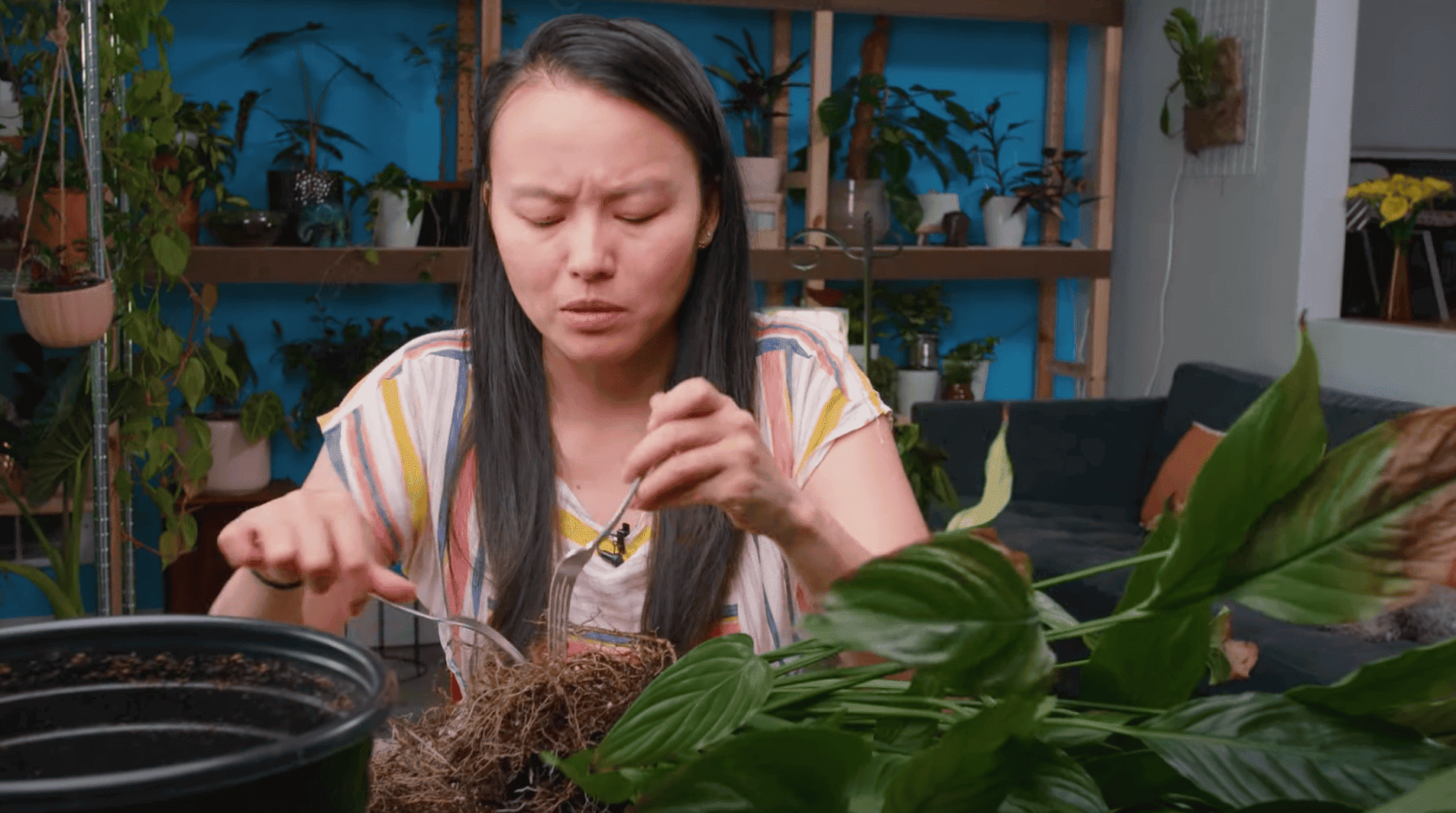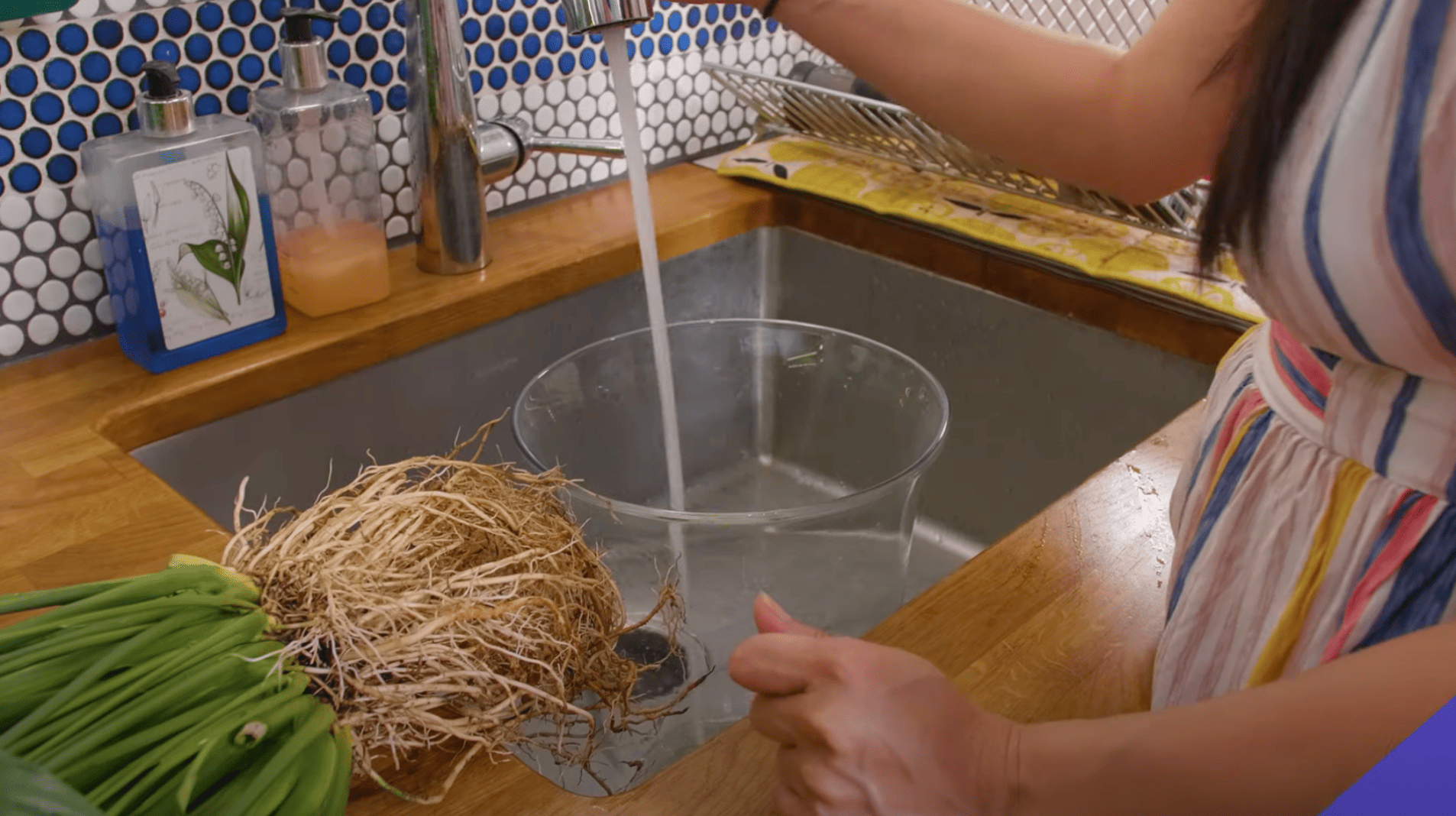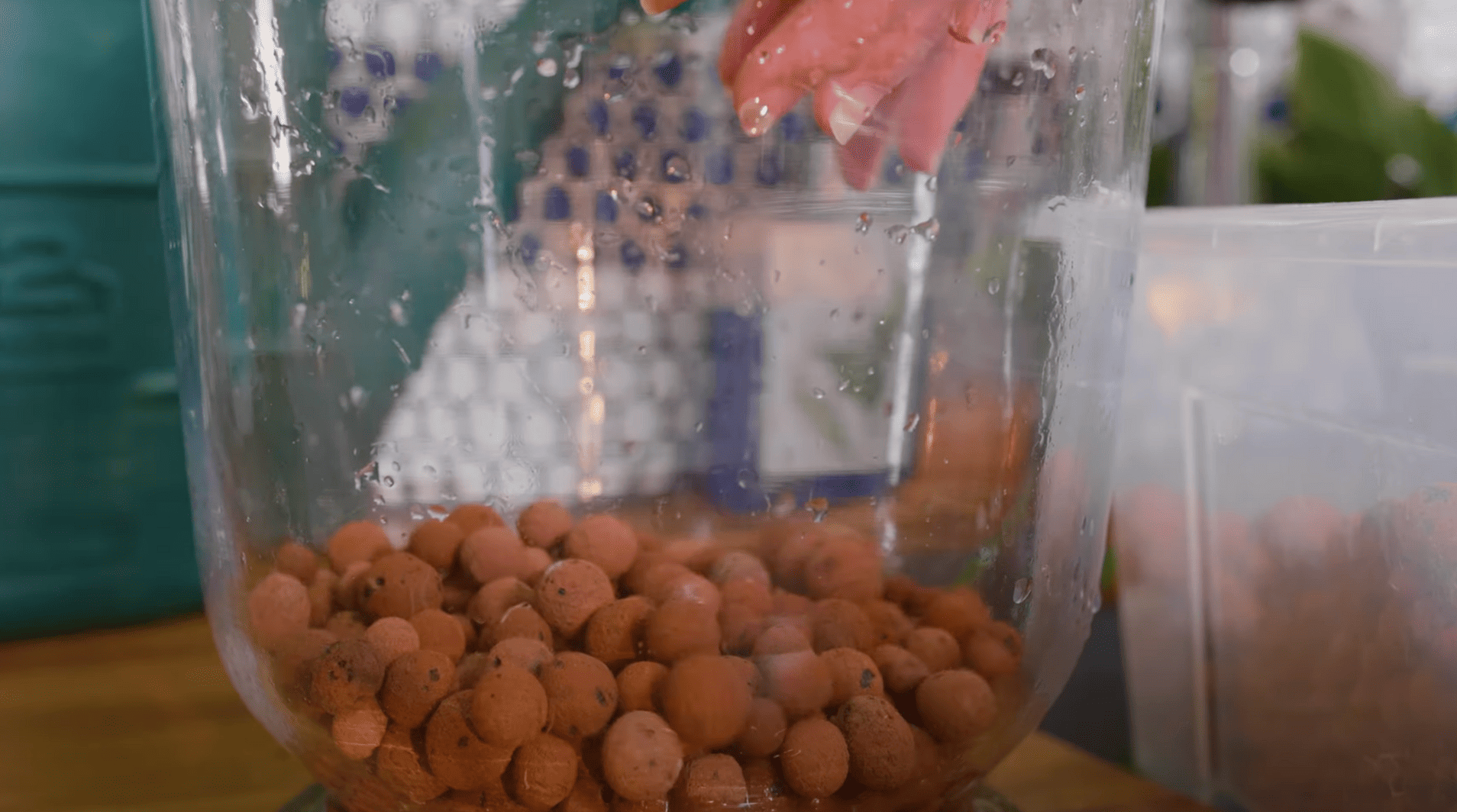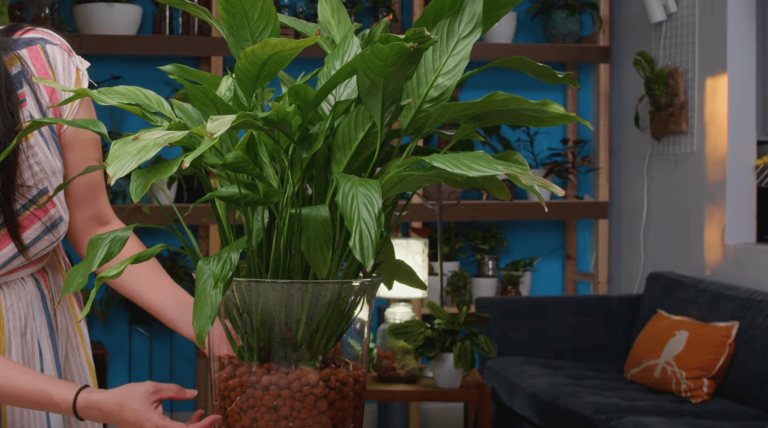Ever thought if your peace lily could flourish without soil? The answer is yes! Peace lilies are among the easiest plants to grow in water.
Their stunning white flowers and glossy leaves can brighten any space, and with hydroponic gardening on the rise, it’s easier than ever to grow them without the mess of soil.
Here, I’ll walk you through the step-by-step process of transitioning your peace lily into water. You’ll learn how to provide the right conditions, maintain healthy growth, and watch your plant flourish in a soil-free environment.
Get ready to find out how easy and rewarding soil-free plant parenting can be!
What is Hydroponic Growing and How Does It Work?
Hydroponic growing involves cultivating plants in water rather than soil. In this method, the roots sit in water that’s mixed with nutrients they would normally get from the ground.
The idea is simple: you remove the soil but still give the plant everything it needs to grow strong and healthy.
The water acts as a carrier for oxygen and nutrients, helping the roots absorb them more directly. This allows plants to grow faster and often healthier, as there’s no soil to block or hold back nutrients.
You’ll also find that hydroponic plants stay cleaner, need less repotting, and face fewer pests or fungus problems. Because you can see the roots through a glass container, it’s easy to spot any issues early and fix them before they spread.
Peace lilies do especially well in hydroponic setups. They’re naturally tolerant of moist environments and can adapt quickly when their roots are cleaned and placed in water.
As long as you keep the water fresh and provide light and nutrients, your peace lily will thrive without a bit of dirt.
Why You Should Grow Peace Lilies in Water
Growing peace lilies in water offers several practical and visual benefits that make plant care easier and more rewarding. Right away, you’ll notice stronger roots, healthier leaves, and steady growth — all without the mess of soil.
1. Cleaner, Healthier Roots: When peace lilies grow in water, their roots stay cleaner and less prone to rot. You can easily see if they’re healthy since white, firm roots mean good growth. The constant access to water also helps them take in nutrients evenly, so you’ll see fewer droopy leaves or dry tips.
2. Low Maintenance Care: Water-grown peace lilies need much less attention than soil-grown ones. You don’t have to worry about overwatering, under-watering, or repotting. Just top up the container when the water level drops and change it every week or two to keep things fresh.
3. Perfect for Small or Indoor Spaces: If you live in an apartment or have limited space, water-growing is ideal. There’s no dirt, no mess, and no need for large pots. A peace lily in a glass vase fits easily on a shelf, desk, or windowsill, bringing greenery to tight spaces.
4. Natural Pest Control: No soil means fewer bugs. Fungus gnats, mites, and other pests that live in damp soil can’t survive in a water-only setup. That makes peace lilies in water a great option for anyone who prefers a cleaner home or has pets and allergies.
5. A Living Piece of Decor: A peace lily in a clear vase is living art. The white roots and glossy green leaves look elegant through the glass, adding a calm, modern touch to any room. You can even experiment with colored glass or decorative stones for a more personalized look.
6. Great for Beginners: If you’ve struggled with houseplants before, this is one of the easiest ways to succeed. Peace lilies are forgiving, adaptable, and respond well to changes. Once you set them up, the upkeep is simple — just fresh water, indirect light, and an occasional nutrient boost.
How to Grow Peace Lilies in Water: Step-By-Step Guide
I’ll walk you through transitioning your peace lily from soil to water in five simple steps. From preparing the plant to ensuring it flourishes in its new water environment, you’ll learn everything you need for healthy, vibrant growth.
Materials You’ll Need
Let’s gather the basics for growing your peace lily in water. You likely already have many of these items at home, or they’re easy to find.
- Peace Lily plant
- Glass vase or container
- LECA (lightweight expanded clay aggregate)
- Water
- Fertilizer (optional)
- Scissors or pruners (for trimming)
With these simple materials, you’re all set to start growing your peace lily in water. Once you have everything ready, you can plunge into the transition process.
Step 1: Prepare the Peace Lily for Transition

Trim any yellow or damaged leaves from the peace lily to encourage healthy growth. Gently remove the roots and rinse them off to remove any remaining dirt.
If you notice any unhealthy or dead roots, carefully trim them away. Handle the plant with care to avoid breaking the roots. This ensures a smooth transition to water, setting the stage for healthy growth.
Step 2: Choose a Suitable Vase

Pick a clear glass vase or container that’s large enough for your peace lily and its roots to spread comfortably. Clear containers are great because they let you see root growth and water levels easily.
However, avoid using narrow-necked bottles since they can restrict airflow and make it hard to remove the plant later. A wide opening allows the roots to breathe and makes water changes simpler.
You can repurpose a candle holder, storage jar, or even a small aquarium. Just make sure it’s clean and free from soap residue. Before placing your plant, rinse the container thoroughly with plain water to remove any lingering chemicals.
Choosing the Right Container for Your Peace Lily
The type of container you choose can make a big difference in how your peace lily grows and how easy it is to care for. Here’s what to keep in mind before you pick one:
- Clear glass vases are perfect for beginners, as you can observe the roots and water level.
- Ceramic or opaque containers help block light, which reduces algae growth. They’re ideal if your setup gets lots of sunlight.
- Plastic containers are lightweight and affordable, but ensure they’re BPA-free and sturdy enough to withstand frequent cleaning.
- Shape and Size: Choose a vase that gives the roots enough space to stretch out but isn’t too large. A medium-sized vase (around 6–8 inches deep) usually works best. Avoid deep, narrow containers that limit airflow or trap old water at the bottom.
- Color and Light Control: Clear containers look beautiful but can encourage algae if exposed to direct light. If that happens, you can wrap the lower half of the vase with paper, fabric, or foil. Use tinted or frosted glass to limit light exposure. Move the plant to a spot with bright, indirect light, rather than direct sunlight.
Step 3: Add LECA for Stability

Place LECA (lightweight expanded clay aggregate) at the bottom of the vase to support the peace lily’s roots. LECA helps suspend the roots in the water, preventing them from sitting at the bottom, which can cause root rot.
It also promotes better water flow, ensuring the roots receive the oxygen they need for healthy growth while keeping the plant stable.
Step 4: Add Water and Monitor the Water Line

Fill the container with water, keeping the water level just below the base of the roots. Avoid submerging the plant’s base in water, as it may lead to rot.
Check the water level regularly and top it up as needed. Change the water every few days to keep it fresh, which helps prevent stagnation and promotes strong root growth.
Step 5: Provide Care and Fertilizer

Keep an eye on your peace lily after it’s in its new water setup. Regularly change the water and top it off as needed. Consider adding a small amount of fertilizer to support its growth, but be cautious not to over-fertilize.
Follow recommended guidelines for fertilization to prevent nutrient burn. Watch for any signs of stress and adjust care as needed.
Watch how Its Done: Growing Peace Lilies in Water Video Tutorial
For more information, check out the detailed video explanation by Botanical Woman.
Long-Term Care Tips
To ensure your peace lily flourishes in a hydroponic system, consistency is crucial. Here’s how to keep it healthy and strong for the long haul.
- Get the Light Right: Peace lilies love bright, indirect light. Don’t put them in direct sunlight; it’ll scorch those beautiful leaves.
- Freshen Up the Water: Change the water every 1-2 weeks. This helps avoid debris buildup and keeps the roots happy with fresh oxygen.
- Keep an Eye Out for Pests: Pests aren’t as common in water-grown peace lilies, but a quick inspection never hurts. Look for any signs of mold or bugs.
- Stay on Temperature: Peace lilies like steady warmth, around 65°F–85°F (18°C–29°C). Keep them away from drafts or heaters.
Stick to these simple steps, and your peace lily will stay healthy and vibrant, giving you that lush, green beauty year after year.
Common Challenges with Growing Peace Lilies in Water
When you’re growing peace lilies in water, you might face a few bumps along the way. But don’t worry; I’ve got the tips you need to overcome them. Here’s a quick look at the common issues and easy fixes.
| Challenge | Description | How to Tackle It |
|---|---|---|
| Root Rot | Black, mushy roots from bad water conditions. | Trim off the rotten roots, change out the water regularly, and keep those water levels in check. |
| Water Quality & pH Issues | An imbalanced pH or poor water quality can harm your plant. | Check the pH (keep it between 5.5 and 6.5), use filtered water, and change it frequently. |
| Nutrient Deficiency | Yellow leaves and slow growth are due to a lack of nutrients. | Give a balanced hydroponic fertilizer every 4–6 weeks and watch for any signs of trouble. |
Stay on top of these problems, and your peace lily will keep flourishing in water like a pro!
Troubleshooting Water Problems
Even with good care, your peace lily might show signs that something’s off in its water setup. Here’s a quick guide to identifying issues early and addressing them before they impact your plant’s health.
| Problem | What You’ll Notice | Quick Fix |
|---|---|---|
| Green Algae on Vase Walls | Green film or buildup inside the container. | Move your vase away from direct sunlight, change the water weekly, and try using a darker or opaque container. |
| Cloudy or Smelly Water | The water appears murky or has an unpleasant odor. | Rinse the vase and roots thoroughly. Use filtered or distilled water to avoid chlorine and mineral buildup. |
| Drooping Leaves | Leaves start to wilt or lose firmness. | Check if the plant is too close to heat or drafts. Replace the water and ensure it’s neither too cold nor too hot. |
| Brown Root Tips | Root ends are turning brown or mushy. | Trim damaged roots, rinse them, and refresh the water. Keep the water level just below the base of the plant. |
| Yellowing Leaves | Older leaves are turning yellow even with clean water. | Add a small dose of diluted hydroponic fertilizer — your plant may need nutrients. Also, check that the light isn’t too dim. |
| White or Slimy Film on Roots | Slippery roots or residue on LECA balls. | Remove the plant and clean everything with mild soap and water (rinse well afterward). Refresh the water and monitor for regrowth. |
Extra Tips for Clear, Healthy Water
- Use filtered or distilled water if your tap water is heavy in chlorine or minerals.
- Always rinse the container before each refill. This keeps bacteria and algae away.
- Avoid placing the vase near windows with harsh sunlight or heaters, as this can encourage algae growth or increase water evaporation.
- If you notice repeated buildup, soak the vase in a vinegar-water mixture for 10 minutes, then rinse thoroughly before using it again.
Final Words
Growing peace lilies in water offers numerous benefits, including easier care and healthier roots. Hydroponic methods create stunning displays while simplifying plant maintenance.
Water-grown peace lilies develop stronger root systems and often produce more flowers. Additionally, transparent containers allow you to observe the growth of roots.
By transitioning your peace lily into water, you eliminate soil mess and the guesswork of watering. You’ll enjoy consistent plant health with minimal effort, while your plant becomes a living, decorative piece.
Start your hydroponic peace lily tours today with the techniques I’ve shared. Your plants will reward you with lush growth and beautiful blooms throughout the year. Ready to try water growing? Share your experiences in the comments!













